2018 年广西南宁师范大学综合英语考研真题(B
卷)
学科专业:国语言文学、学科教学(英语)
考试科目:810)综合英语
(答案请写在指定答题纸上,写在本卷上无效。答题时要标明每大题 和小
题序号,卷面整洁有序。本科目满分为 150 分)
1.
Grammar and Vocabulary (共 40 分,每题 2 分)
Directions: There are 20 items in this part. In each item there are
four choices marked with A, B, C, or D. Please choose the BEST one
from the four choices and write the letter you choose to represent
your answer in the corresponding space on your answer sheet.
1.I don't mind her
jewels at the party
A.wear jewels
B. wearing jewels
C. to wear jewels
D. being wearing jewels
2.Broadly speaking, human being may be divided into three classes:
those who are toiled to death, those who are
to death and those
who are
to death.
A.worried, bored
B. worrying, bored
C. worried, boring
D. worrying, boring
3.In which of the following sentences , the underlined part is NOT
an absolute construction ?
A.The cowboy dominates the pages of many magazines, his hair dark and
curly.
B.The boys learned against the willow tree, their fishing poles
resting on sticks.
C .Diana stood motionless at the end of the diving board, her hands
at her sides.
�
D. All of this being said, I believe that the key to realizing the
dream is to work harder.
4.Which of the following sentence has a wrong word order?
A. Hardly had he arrived when she started complaining.
B.Under no circumstance you must touch this switch.
C.Only after several trials did they succeed finally.
D.Not only did he speak correctly but also convincingly.
5.This kind of glasses manufactured by experienced craftsmen
well.
A.is sold
B.selling
C.are sold
D.sells
6.They can vote in
district they choose.
A. whichever
B. whenever
C. wherever
D. however
7. something happens to the brain's development during pregnancy, it
is more likely
affected in a male.
A.being
B.would be
C.to be
D.be
8.
he disagreed with the idea, he was willing to go along
with the majority.
�
A.As
B.As much
C.Much as
D.As much as
9.A person can actually do any job that they get the right
qualifications fbr it and work hard at it.
A.provided
B.lest
C.granted
D.despite
10.Which of the following past participles is used as predictive(表
语)?
A.
B.
C.
D.
His wound became infected with the new virus.
The terrified people calmed down gradually.
The endangered animals may even die out.
It came from the river polluted by the dirty water.
11.
allow the vegetable to go bad, he sold them at half price.
A.More than
B.Other than
C.Rather than
D.Much than
12.The original building was erected in 1710, but this structure has
been largely transformed and
.
A.increased
�
B.extended
C.lengther
than
D.Much than
14. She was cheered by the news from home. The underlined part means
.
A.excited
B. encouraged
C.annoyed
D.worried
15. Some people either
neutralabout them.
A. violently
B. sincerely
C.thusiastically
avoid questions of right and wrong or remain
D. enthusiastically
16. He had tried everything, but it made little
A. effect
B. difference
C. outcome
D. result
17. We will never fail to
what our parents expect of us.
A. live
B. live with
C. live through
D. live up to
18. He spoke so
that even his opponents were won over by his
�
arguments.
A.bluntly
B. convincingly
C.emphatically
D.determinedly
19. People who live in small towns often seem more friendly than those
living inpopulated areas.
A. live up to
B. intensely
C. abundantly
D. highly
20. The train was
its way through the mountains.
A. cocking
B. snaking
C. craning
D. ducking
�
II. Cloze (共 20 分,每空 2 分)
Directions: In this part, there is a passage with TEN blanks. You
are required to select One word far each blank from a list of 15 words
given in a word bank before the passage. Each word in the bank is
identified by a letter. Please write the corresponding letter for each
blank on your Answer Sheet. The word in the bank can be used only ONCE.
A. exception B. ultimately C. embarrass D. concepts E. tolerance F.
oppress G. target H. adaptable I. stressed J. temporarily K.
comfortable L. procedures M. approaches N. enjoyable O. where
Here are the three most common mistakes language learners make —
and how to correct them.
Rigid thinking
Linguists have found that students with a low (1)
of
ambiguity tend to struggle with language learning. Language learning
involves a lot of uncertainty —students will encounter new vo cabulary
daily, and for each grammar rule there will be a dialectic (2)
or
irregular verb. Until native-like fluency is achieved, there will
always be some level of ambiguity. The type of learner who sees a new
word and reaches for the dictionary instead of guessing the meaning
from the context may feel (3)
and disoriented in an immersion
class. They might (4)
quit their language studies out of sheer
frustration. It's a difficult mindset to break, but small exercises
�
can help. Find a song or text in the (5)
language and practice
figuring out the gist, even if a few words are unknown.
A single method
Some learners are most (6)
with the listen-and-repeat drills
of a language lab or podcast. Some need a grammar textbook to make sense
of a foreign tongue. Each of these (7)
is fine, but it's a mistake
to rely on only one. Language learners who use multiple methods get
to practice different skills and see (8)
explained in different
ways. What's more, the variety can keep them from getting stuck in a
learning rut.
Fear
In Eastern cultures (9)
saving face is a strong social value.
EFL teachers often complain that students, despite years of studying
English, simply will not speak it. They're too afraid of making
grammatical mistakes or mispronouncing words in a way that would (10)
them.
III. Reading Comprehension (共 40 分,每个问题 2 分)
Directions: There are FOUR texts in this part. Each text is followed
by 5 questions. You need to make the best choice from the four options
marked with A, B, C, or D to answer each question..
Questions 1-5 are based the following text.
�
Text A
Sometimes your biggest weakness can become your biggest strength.
Take, for example, the story of one 10-year-old boy who decided to study
judo despite the fact that he had lost his left arm in a devastating
car accident.
The boy began lessons with an old Japanese judo master. The boy
was doing well, so he couldn't understand why, after three months of
training, the master had taught him only one move.
"Sensei ( v 日语〉教练),” the boy finally said, ''shouldn't I
be learning more moves?"
"This is the only move you know, but this is the only move you'll
ever need to know," the sensei replied.
Not quite understanding, but believing in his teacher, the boy kept
training.
Several months later, the sensei took the boy to his first
tournament.
Surprising himself, the boy easily won his first two matches. The
third match proved to he more difficult, but after some time, his
opponent became impatient and charged; the boy deftly used his one move
to win the match. Still amazed by his success, the boy was now in the
finals.
This time, his opponent was bigger, stronger, and more experienced.
For a while, the boy appeared to be overmatched. Concerned that the
boy might get hurt, the referee called a time out. He was about to stop
the match when the sensei intervened.
"No," the sensei insisted, "let him continue."
�


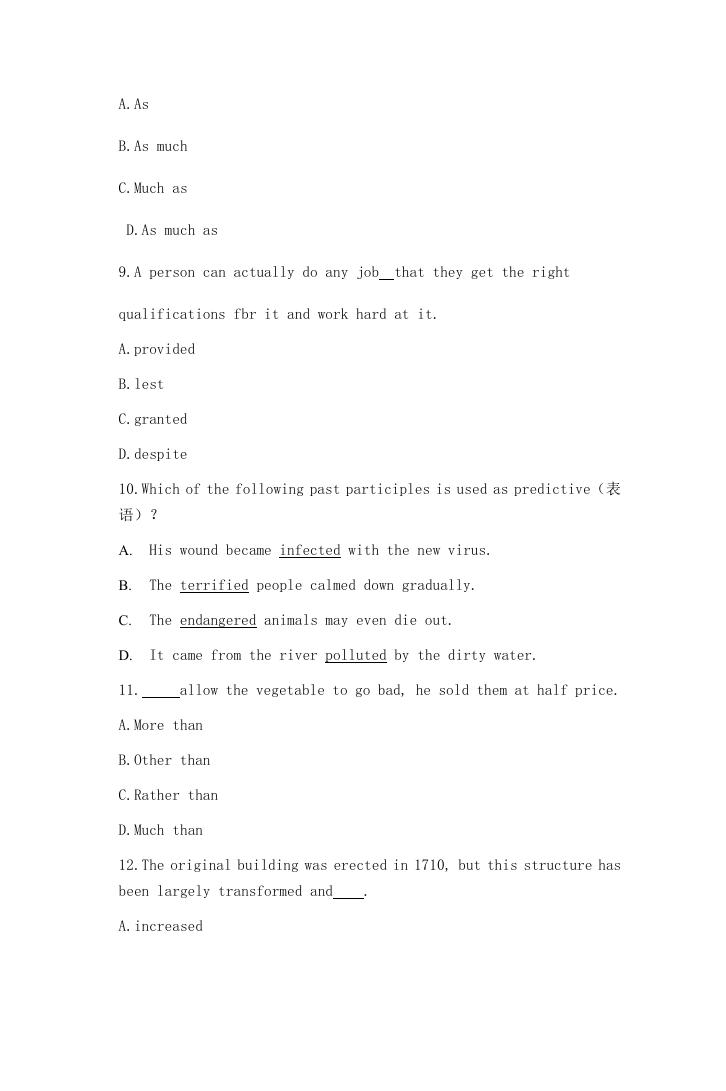
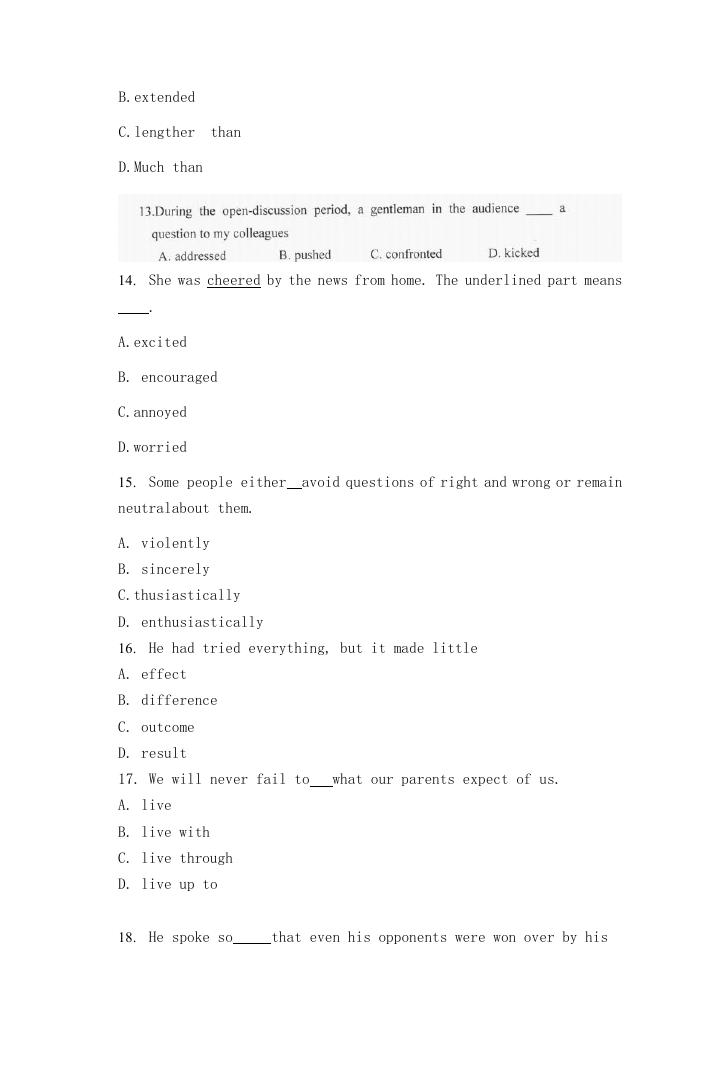
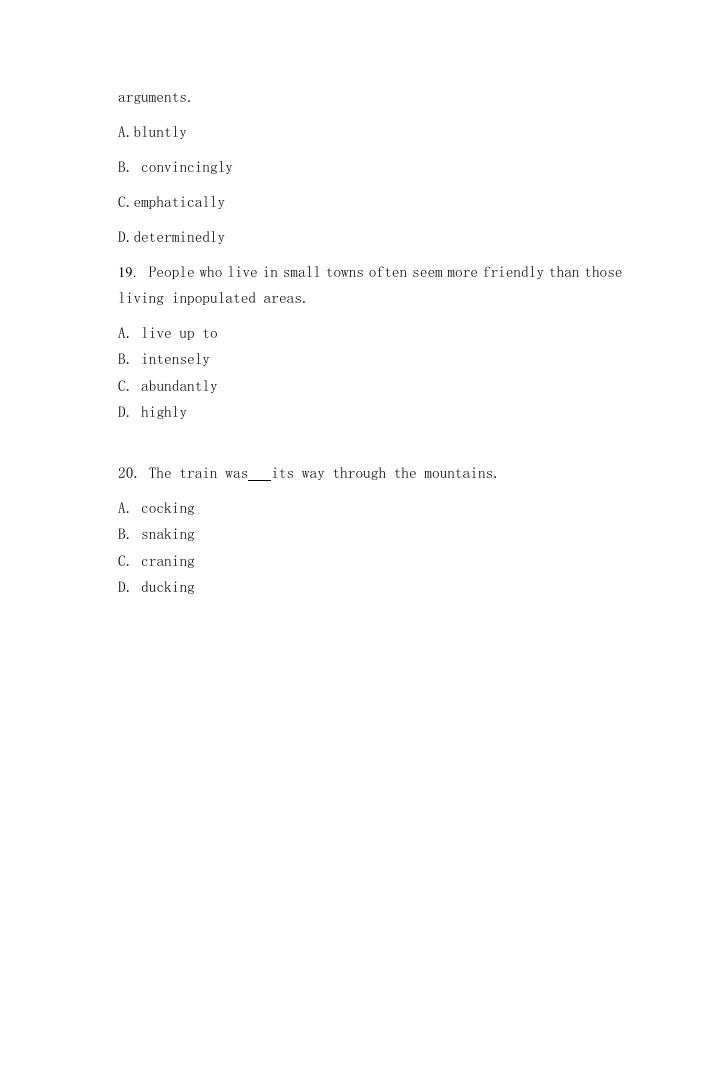
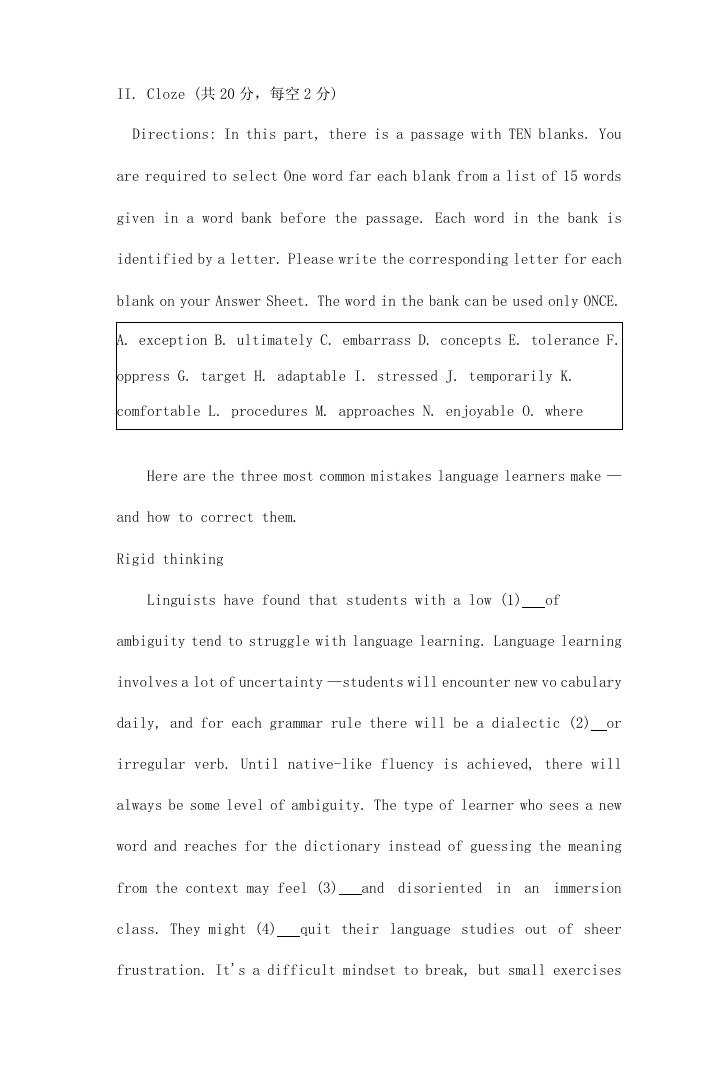
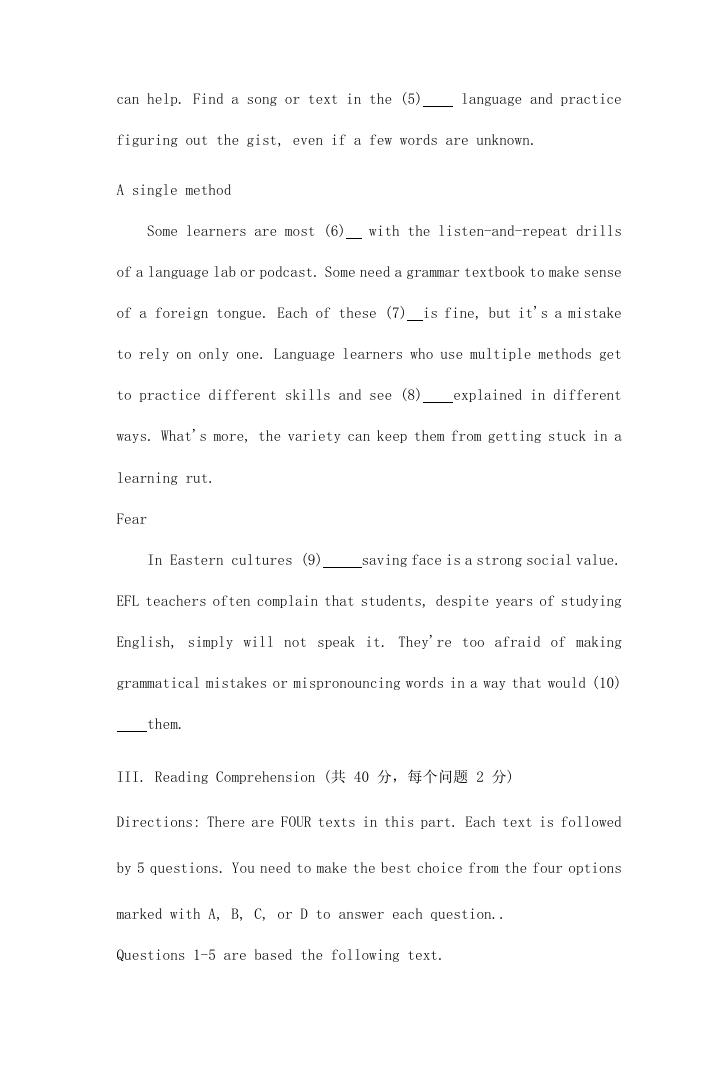
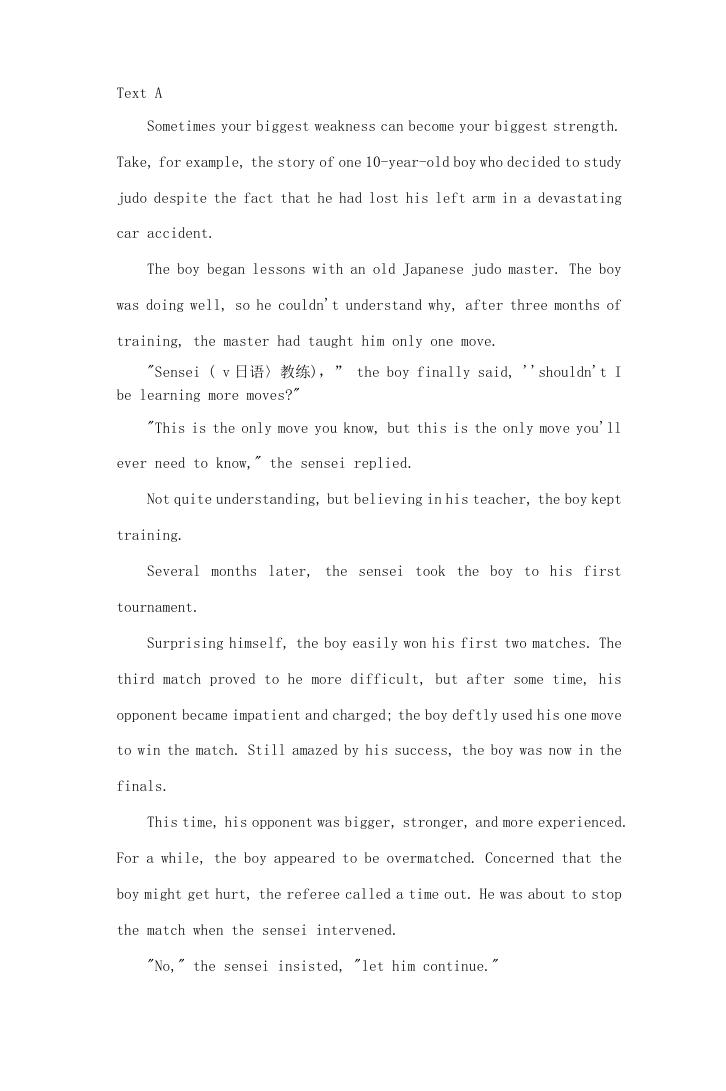








 2023年江西萍乡中考道德与法治真题及答案.doc
2023年江西萍乡中考道德与法治真题及答案.doc 2012年重庆南川中考生物真题及答案.doc
2012年重庆南川中考生物真题及答案.doc 2013年江西师范大学地理学综合及文艺理论基础考研真题.doc
2013年江西师范大学地理学综合及文艺理论基础考研真题.doc 2020年四川甘孜小升初语文真题及答案I卷.doc
2020年四川甘孜小升初语文真题及答案I卷.doc 2020年注册岩土工程师专业基础考试真题及答案.doc
2020年注册岩土工程师专业基础考试真题及答案.doc 2023-2024学年福建省厦门市九年级上学期数学月考试题及答案.doc
2023-2024学年福建省厦门市九年级上学期数学月考试题及答案.doc 2021-2022学年辽宁省沈阳市大东区九年级上学期语文期末试题及答案.doc
2021-2022学年辽宁省沈阳市大东区九年级上学期语文期末试题及答案.doc 2022-2023学年北京东城区初三第一学期物理期末试卷及答案.doc
2022-2023学年北京东城区初三第一学期物理期末试卷及答案.doc 2018上半年江西教师资格初中地理学科知识与教学能力真题及答案.doc
2018上半年江西教师资格初中地理学科知识与教学能力真题及答案.doc 2012年河北国家公务员申论考试真题及答案-省级.doc
2012年河北国家公务员申论考试真题及答案-省级.doc 2020-2021学年江苏省扬州市江都区邵樊片九年级上学期数学第一次质量检测试题及答案.doc
2020-2021学年江苏省扬州市江都区邵樊片九年级上学期数学第一次质量检测试题及答案.doc 2022下半年黑龙江教师资格证中学综合素质真题及答案.doc
2022下半年黑龙江教师资格证中学综合素质真题及答案.doc